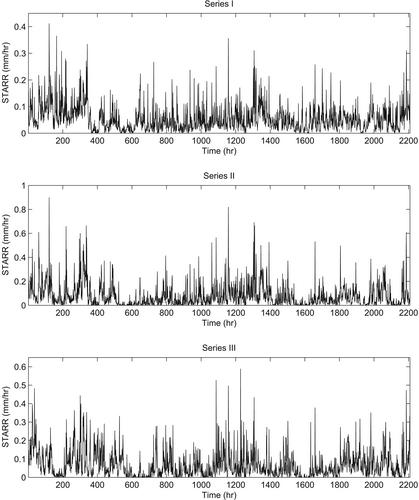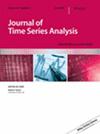下载PDF
{"title":"关于高偏斜分数对数稳定噪声序列及其应用","authors":"Harry Pavlopoulos, George Chronis","doi":"10.1111/jtsa.12671","DOIUrl":null,"url":null,"abstract":"<p>Considering log-LFSN (log-linear fractional stable noise) sequences <math>\n <msub>\n <mrow>\n <mo>{</mo>\n <msub>\n <mrow>\n <mi>Y</mi>\n </mrow>\n <mrow>\n <mi>n</mi>\n </mrow>\n </msub>\n <mo>=</mo>\n <msup>\n <mrow>\n <mi>e</mi>\n </mrow>\n <mrow>\n <mi>δ</mi>\n <mo>·</mo>\n <msub>\n <mrow>\n <mi>X</mi>\n </mrow>\n <mrow>\n <mi>n</mi>\n </mrow>\n </msub>\n <mo>+</mo>\n <mi>ε</mi>\n </mrow>\n </msup>\n <mo>}</mo>\n </mrow>\n <mrow>\n <mi>n</mi>\n <mo>∈</mo>\n <mi>ℤ</mi>\n </mrow>\n </msub></math>, driven by non-Gaussian one-sided LFSN <math>\n <msub>\n <mrow>\n <mo>{</mo>\n <msub>\n <mrow>\n <mi>X</mi>\n </mrow>\n <mrow>\n <mi>n</mi>\n </mrow>\n </msub>\n <mo>}</mo>\n </mrow>\n <mrow>\n <mi>n</mi>\n <mo>∈</mo>\n <mi>ℤ</mi>\n </mrow>\n </msub></math> with constant skewness intensity <math>\n <msub>\n <mrow>\n <mi>β</mi>\n </mrow>\n <mrow>\n <mn>0</mn>\n </mrow>\n </msub>\n <mo>∈</mo>\n <mo>[</mo>\n <mo>−</mo>\n <mn>1</mn>\n <mo>,</mo>\n <mn>1</mn>\n <mo>]</mo></math>, for any <math>\n <mi>δ</mi>\n <mo>∈</mo>\n <mi>ℝ</mi>\n <mo>−</mo>\n <mo>{</mo>\n <mn>0</mn>\n <mo>}</mo></math> and <math>\n <mi>ε</mi>\n <mo>∈</mo>\n <mi>ℝ</mi></math>, we show that the auto-covariance function (ACVF) <math>\n <msub>\n <mrow>\n <mo>{</mo>\n <msub>\n <mrow>\n <mi>γ</mi>\n </mrow>\n <mrow>\n <mi>Y</mi>\n </mrow>\n </msub>\n <mo>(</mo>\n <mi>h</mi>\n <mo>)</mo>\n <mo>}</mo>\n </mrow>\n <mrow>\n <mi>h</mi>\n <mo>∈</mo>\n <mi>ℤ</mi>\n </mrow>\n </msub></math> exists if and only if <math>\n <msub>\n <mrow>\n <mo>{</mo>\n <msub>\n <mrow>\n <mi>X</mi>\n </mrow>\n <mrow>\n <mi>n</mi>\n </mrow>\n </msub>\n <mo>}</mo>\n </mrow>\n <mrow>\n <mi>n</mi>\n <mo>∈</mo>\n <mi>ℤ</mi>\n </mrow>\n </msub></math> is persistent, with stability index <math>\n <mi>α</mi>\n <mo>∈</mo>\n <mo>(</mo>\n <mn>1</mn>\n <mo>,</mo>\n <mn>2</mn>\n <mo>)</mo></math>, Hurst exponent <math>\n <mi>H</mi>\n <mo>∈</mo>\n <mo>(</mo>\n <mn>1</mn>\n <mo>/</mo>\n <mi>α</mi>\n <mo>,</mo>\n <mn>1</mn>\n <mo>)</mo></math> and extreme skewness <math>\n <msub>\n <mrow>\n <mi>β</mi>\n </mrow>\n <mrow>\n <mn>0</mn>\n </mrow>\n </msub>\n <mo>=</mo>\n <mo>−</mo>\n <mn>1</mn></math> (if <math>\n <mi>δ</mi>\n <mo>></mo>\n <mn>0</mn></math>) or <math>\n <msub>\n <mrow>\n <mi>β</mi>\n </mrow>\n <mrow>\n <mn>0</mn>\n </mrow>\n </msub>\n <mo>=</mo>\n <mn>1</mn></math> (if <math>\n <mi>δ</mi>\n <mo><</mo>\n <mn>0</mn></math>). Within that range of existence, <math>\n <mn>1</mn>\n <mo>/</mo>\n <mn>2</mn>\n <mo><</mo>\n <mn>1</mn>\n <mo>/</mo>\n <mi>α</mi>\n <mo><</mo>\n <mi>H</mi>\n <mo><</mo>\n <mn>1</mn></math> and <math>\n <mo>|</mo>\n <msub>\n <mrow>\n <mi>β</mi>\n </mrow>\n <mrow>\n <mn>0</mn>\n </mrow>\n </msub>\n <mo>|</mo>\n <mo>=</mo>\n <mn>1</mn></math> in short, we calculate <math>\n <msub>\n <mrow>\n <mo>{</mo>\n <msub>\n <mrow>\n <mi>γ</mi>\n </mrow>\n <mrow>\n <mi>Y</mi>\n </mrow>\n </msub>\n <mo>(</mo>\n <mi>h</mi>\n <mo>)</mo>\n <mo>}</mo>\n </mrow>\n <mrow>\n <mi>h</mi>\n <mo>∈</mo>\n <mi>ℤ</mi>\n </mrow>\n </msub></math> explicitly and establish persistence of <math>\n <msub>\n <mrow>\n <mo>{</mo>\n <msub>\n <mrow>\n <mi>Y</mi>\n </mrow>\n <mrow>\n <mi>n</mi>\n </mrow>\n </msub>\n <mo>}</mo>\n </mrow>\n <mrow>\n <mi>n</mi>\n <mo>∈</mo>\n <mi>ℤ</mi>\n </mrow>\n </msub></math> too, by showing asymptotic proportionality of <math>\n <msub>\n <mrow>\n <mi>γ</mi>\n </mrow>\n <mrow>\n <mi>Y</mi>\n </mrow>\n </msub>\n <mo>(</mo>\n <mi>h</mi>\n <mo>)</mo>\n <mo>≈</mo>\n <mo>|</mo>\n <mi>h</mi>\n <msup>\n <mrow>\n <mo>|</mo>\n </mrow>\n <mrow>\n <mi>α</mi>\n <mo>·</mo>\n <mo>(</mo>\n <mi>H</mi>\n <mo>−</mo>\n <mn>1</mn>\n <mo>)</mo>\n </mrow>\n </msup></math>, as <math>\n <mi>h</mi>\n <mo>→</mo>\n <mi>∞</mi></math>. We discuss explicit links of <math>\n <msub>\n <mrow>\n <mo>{</mo>\n <msub>\n <mrow>\n <mi>γ</mi>\n </mrow>\n <mrow>\n <mi>Y</mi>\n </mrow>\n </msub>\n <mo>(</mo>\n <mi>h</mi>\n <mo>)</mo>\n <mo>}</mo>\n </mrow>\n <mrow>\n <mi>h</mi>\n <mo>∈</mo>\n <mi>ℤ</mi>\n </mrow>\n </msub></math> to a generalized co-difference function of the driving one-sided LFSN <math>\n <msub>\n <mrow>\n <mo>{</mo>\n <msub>\n <mrow>\n <mi>X</mi>\n </mrow>\n <mrow>\n <mi>n</mi>\n </mrow>\n </msub>\n <mo>}</mo>\n </mrow>\n <mrow>\n <mi>n</mi>\n <mo>∈</mo>\n <mi>ℤ</mi>\n </mrow>\n </msub></math>, and to the ACVF's of fractional Gaussian noise (FGN) and log-FGN. The results are numerically demonstrated via ensemble simulation of synthetic time series generated by the considered log-LFSN model fitted to time series of spatio-temporal accumulations of rain rate data.</p>","PeriodicalId":49973,"journal":{"name":"Journal of Time Series Analysis","volume":null,"pages":null},"PeriodicalIF":1.2000,"publicationDate":"2022-11-13","publicationTypes":"Journal Article","fieldsOfStudy":null,"isOpenAccess":false,"openAccessPdf":"https://onlinelibrary.wiley.com/doi/epdf/10.1111/jtsa.12671","citationCount":"0","resultStr":"{\"title\":\"On highly skewed fractional log-stable noise sequences and their application\",\"authors\":\"Harry Pavlopoulos, George Chronis\",\"doi\":\"10.1111/jtsa.12671\",\"DOIUrl\":null,\"url\":null,\"abstract\":\"<p>Considering log-LFSN (log-linear fractional stable noise) sequences <math>\\n <msub>\\n <mrow>\\n <mo>{</mo>\\n <msub>\\n <mrow>\\n <mi>Y</mi>\\n </mrow>\\n <mrow>\\n <mi>n</mi>\\n </mrow>\\n </msub>\\n <mo>=</mo>\\n <msup>\\n <mrow>\\n <mi>e</mi>\\n </mrow>\\n <mrow>\\n <mi>δ</mi>\\n <mo>·</mo>\\n <msub>\\n <mrow>\\n <mi>X</mi>\\n </mrow>\\n <mrow>\\n <mi>n</mi>\\n </mrow>\\n </msub>\\n <mo>+</mo>\\n <mi>ε</mi>\\n </mrow>\\n </msup>\\n <mo>}</mo>\\n </mrow>\\n <mrow>\\n <mi>n</mi>\\n <mo>∈</mo>\\n <mi>ℤ</mi>\\n </mrow>\\n </msub></math>, driven by non-Gaussian one-sided LFSN <math>\\n <msub>\\n <mrow>\\n <mo>{</mo>\\n <msub>\\n <mrow>\\n <mi>X</mi>\\n </mrow>\\n <mrow>\\n <mi>n</mi>\\n </mrow>\\n </msub>\\n <mo>}</mo>\\n </mrow>\\n <mrow>\\n <mi>n</mi>\\n <mo>∈</mo>\\n <mi>ℤ</mi>\\n </mrow>\\n </msub></math> with constant skewness intensity <math>\\n <msub>\\n <mrow>\\n <mi>β</mi>\\n </mrow>\\n <mrow>\\n <mn>0</mn>\\n </mrow>\\n </msub>\\n <mo>∈</mo>\\n <mo>[</mo>\\n <mo>−</mo>\\n <mn>1</mn>\\n <mo>,</mo>\\n <mn>1</mn>\\n <mo>]</mo></math>, for any <math>\\n <mi>δ</mi>\\n <mo>∈</mo>\\n <mi>ℝ</mi>\\n <mo>−</mo>\\n <mo>{</mo>\\n <mn>0</mn>\\n <mo>}</mo></math> and <math>\\n <mi>ε</mi>\\n <mo>∈</mo>\\n <mi>ℝ</mi></math>, we show that the auto-covariance function (ACVF) <math>\\n <msub>\\n <mrow>\\n <mo>{</mo>\\n <msub>\\n <mrow>\\n <mi>γ</mi>\\n </mrow>\\n <mrow>\\n <mi>Y</mi>\\n </mrow>\\n </msub>\\n <mo>(</mo>\\n <mi>h</mi>\\n <mo>)</mo>\\n <mo>}</mo>\\n </mrow>\\n <mrow>\\n <mi>h</mi>\\n <mo>∈</mo>\\n <mi>ℤ</mi>\\n </mrow>\\n </msub></math> exists if and only if <math>\\n <msub>\\n <mrow>\\n <mo>{</mo>\\n <msub>\\n <mrow>\\n <mi>X</mi>\\n </mrow>\\n <mrow>\\n <mi>n</mi>\\n </mrow>\\n </msub>\\n <mo>}</mo>\\n </mrow>\\n <mrow>\\n <mi>n</mi>\\n <mo>∈</mo>\\n <mi>ℤ</mi>\\n </mrow>\\n </msub></math> is persistent, with stability index <math>\\n <mi>α</mi>\\n <mo>∈</mo>\\n <mo>(</mo>\\n <mn>1</mn>\\n <mo>,</mo>\\n <mn>2</mn>\\n <mo>)</mo></math>, Hurst exponent <math>\\n <mi>H</mi>\\n <mo>∈</mo>\\n <mo>(</mo>\\n <mn>1</mn>\\n <mo>/</mo>\\n <mi>α</mi>\\n <mo>,</mo>\\n <mn>1</mn>\\n <mo>)</mo></math> and extreme skewness <math>\\n <msub>\\n <mrow>\\n <mi>β</mi>\\n </mrow>\\n <mrow>\\n <mn>0</mn>\\n </mrow>\\n </msub>\\n <mo>=</mo>\\n <mo>−</mo>\\n <mn>1</mn></math> (if <math>\\n <mi>δ</mi>\\n <mo>></mo>\\n <mn>0</mn></math>) or <math>\\n <msub>\\n <mrow>\\n <mi>β</mi>\\n </mrow>\\n <mrow>\\n <mn>0</mn>\\n </mrow>\\n </msub>\\n <mo>=</mo>\\n <mn>1</mn></math> (if <math>\\n <mi>δ</mi>\\n <mo><</mo>\\n <mn>0</mn></math>). Within that range of existence, <math>\\n <mn>1</mn>\\n <mo>/</mo>\\n <mn>2</mn>\\n <mo><</mo>\\n <mn>1</mn>\\n <mo>/</mo>\\n <mi>α</mi>\\n <mo><</mo>\\n <mi>H</mi>\\n <mo><</mo>\\n <mn>1</mn></math> and <math>\\n <mo>|</mo>\\n <msub>\\n <mrow>\\n <mi>β</mi>\\n </mrow>\\n <mrow>\\n <mn>0</mn>\\n </mrow>\\n </msub>\\n <mo>|</mo>\\n <mo>=</mo>\\n <mn>1</mn></math> in short, we calculate <math>\\n <msub>\\n <mrow>\\n <mo>{</mo>\\n <msub>\\n <mrow>\\n <mi>γ</mi>\\n </mrow>\\n <mrow>\\n <mi>Y</mi>\\n </mrow>\\n </msub>\\n <mo>(</mo>\\n <mi>h</mi>\\n <mo>)</mo>\\n <mo>}</mo>\\n </mrow>\\n <mrow>\\n <mi>h</mi>\\n <mo>∈</mo>\\n <mi>ℤ</mi>\\n </mrow>\\n </msub></math> explicitly and establish persistence of <math>\\n <msub>\\n <mrow>\\n <mo>{</mo>\\n <msub>\\n <mrow>\\n <mi>Y</mi>\\n </mrow>\\n <mrow>\\n <mi>n</mi>\\n </mrow>\\n </msub>\\n <mo>}</mo>\\n </mrow>\\n <mrow>\\n <mi>n</mi>\\n <mo>∈</mo>\\n <mi>ℤ</mi>\\n </mrow>\\n </msub></math> too, by showing asymptotic proportionality of <math>\\n <msub>\\n <mrow>\\n <mi>γ</mi>\\n </mrow>\\n <mrow>\\n <mi>Y</mi>\\n </mrow>\\n </msub>\\n <mo>(</mo>\\n <mi>h</mi>\\n <mo>)</mo>\\n <mo>≈</mo>\\n <mo>|</mo>\\n <mi>h</mi>\\n <msup>\\n <mrow>\\n <mo>|</mo>\\n </mrow>\\n <mrow>\\n <mi>α</mi>\\n <mo>·</mo>\\n <mo>(</mo>\\n <mi>H</mi>\\n <mo>−</mo>\\n <mn>1</mn>\\n <mo>)</mo>\\n </mrow>\\n </msup></math>, as <math>\\n <mi>h</mi>\\n <mo>→</mo>\\n <mi>∞</mi></math>. We discuss explicit links of <math>\\n <msub>\\n <mrow>\\n <mo>{</mo>\\n <msub>\\n <mrow>\\n <mi>γ</mi>\\n </mrow>\\n <mrow>\\n <mi>Y</mi>\\n </mrow>\\n </msub>\\n <mo>(</mo>\\n <mi>h</mi>\\n <mo>)</mo>\\n <mo>}</mo>\\n </mrow>\\n <mrow>\\n <mi>h</mi>\\n <mo>∈</mo>\\n <mi>ℤ</mi>\\n </mrow>\\n </msub></math> to a generalized co-difference function of the driving one-sided LFSN <math>\\n <msub>\\n <mrow>\\n <mo>{</mo>\\n <msub>\\n <mrow>\\n <mi>X</mi>\\n </mrow>\\n <mrow>\\n <mi>n</mi>\\n </mrow>\\n </msub>\\n <mo>}</mo>\\n </mrow>\\n <mrow>\\n <mi>n</mi>\\n <mo>∈</mo>\\n <mi>ℤ</mi>\\n </mrow>\\n </msub></math>, and to the ACVF's of fractional Gaussian noise (FGN) and log-FGN. The results are numerically demonstrated via ensemble simulation of synthetic time series generated by the considered log-LFSN model fitted to time series of spatio-temporal accumulations of rain rate data.</p>\",\"PeriodicalId\":49973,\"journal\":{\"name\":\"Journal of Time Series Analysis\",\"volume\":null,\"pages\":null},\"PeriodicalIF\":1.2000,\"publicationDate\":\"2022-11-13\",\"publicationTypes\":\"Journal Article\",\"fieldsOfStudy\":null,\"isOpenAccess\":false,\"openAccessPdf\":\"https://onlinelibrary.wiley.com/doi/epdf/10.1111/jtsa.12671\",\"citationCount\":\"0\",\"resultStr\":null,\"platform\":\"Semanticscholar\",\"paperid\":null,\"PeriodicalName\":\"Journal of Time Series Analysis\",\"FirstCategoryId\":\"100\",\"ListUrlMain\":\"https://onlinelibrary.wiley.com/doi/10.1111/jtsa.12671\",\"RegionNum\":4,\"RegionCategory\":\"数学\",\"ArticlePicture\":[],\"TitleCN\":null,\"AbstractTextCN\":null,\"PMCID\":null,\"EPubDate\":\"\",\"PubModel\":\"\",\"JCR\":\"Q3\",\"JCRName\":\"MATHEMATICS, INTERDISCIPLINARY APPLICATIONS\",\"Score\":null,\"Total\":0}","platform":"Semanticscholar","paperid":null,"PeriodicalName":"Journal of Time Series Analysis","FirstCategoryId":"100","ListUrlMain":"https://onlinelibrary.wiley.com/doi/10.1111/jtsa.12671","RegionNum":4,"RegionCategory":"数学","ArticlePicture":[],"TitleCN":null,"AbstractTextCN":null,"PMCID":null,"EPubDate":"","PubModel":"","JCR":"Q3","JCRName":"MATHEMATICS, INTERDISCIPLINARY APPLICATIONS","Score":null,"Total":0}
引用次数: 0
引用
批量引用



